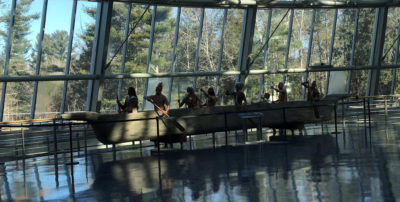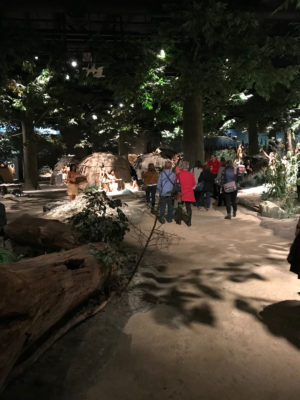Local Knowledge and Public History
13 June 2019 – Dean Herrin
maritime history, tours, 2019 annual meeting, Hartford series 2019, Indigenous People, American Indians

A display at the Mashantucket Pequot Museum & Research Center in Ledyard, CT. Photo credit: Dean Herrin.
During the annual meeting of the National Council for Public History in Hartford in March, I had the good fortune to be on the tour of the Mashantucket Pequot Museum & Research Center, and of Mystic Seaport, both in eastern Connecticut about an hour’s drive from Hartford. The Pequot Museum, a site of the Mashantucket Pequot Tribal Nation, presents the life and history of the Pequot Indians of the region, who once controlled a vast territory in New England. In Mystic, we toured the shipyard where the Mayflower II is being restored for the 400th anniversary of the landing of the Pilgrims in Massachusetts.
The persistence of the Pequot is an important theme throughout the Pequot Museum and Research Center. “The Last of the Pequots” seems to have been a literary trope since the early 1800s (and a wished-for extinction by various governmental entities). Yet, the words attributed (at least as early as his 1910 New York Times obituary) of another famous Connecticut resident, Mark Twain, are apt: “The reports of my death are highly exaggerated.” Indeed, the Pequot Nation is alive and well and has important things to share. In addition to thoughtful and informative displays about the history of the Pequot Nation, the museum also exhibits modern interpretations of traditional Pequot crafts by native artisans, showing the continuity of tribal knowledge and skill.

NCPH members touring the recreated village setting at the Mashantucket Pequot Museum & Research Center in Ledyard, CT. Photo credit: Dean Herrin.
But to survive, the Pequots had to adapt. Throughout their history, the Pequots were so harassed and swindled by white settlers and politicians that eventually the tribe’s land was too small to sustain their traditional way of life. Members of the tribe had to find alternative means of survival, and many men turned to whaling and the life of the sea. Seafaring industries have long been noted as more integrated than other occupations in the United States, perhaps because skill and courage were more valued than skin color in dangerous endeavors such as whaling. One of the historic ships docked at Mystic Seaport is the Charles W. Morgan, a whaling ship launched in the 1840s that included several American Indians as crew members through the years (although I do not know if anyone from the Pequot Nation was ever part of the Morgan crew). This history of a symbiotic relationship has led the Pequot Museum and Mystic Seaport to partner in recent years on several projects to explore this connection.
Our visit to Mystic Seaport was focused on the restoration of the Mayflower II, the 1950s “reproduction” of the original Mayflower. The ship is a main attraction at Plimouth Plantation in Massachusetts and is being restored for the 400th anniversary of the Pilgrims’ landing in 1620. The Mayflower II was constructed in England in 1955-56, sailed to the United States in 1957, and was donated to Plimouth Plantation in appreciation for U.S. support of Great Britain during World War II. Since no blueprints of the original Mayflower exist, Mayflower II was a “guestimate” based on extensive research on the construction of other English merchant ships of the day. I found all this very interesting, and fascinating in a history-of-preservation-and-public-history sort of way. But I had not been aware before the tour that our trip to Mystic would be focused on the Mayflower II, and as a first-time visitor to Mystic Seaport, I found myself itching to go and see the more “authentic” (or at least older) Charles W. Morgan, the historic whaling ship built in 1841.
What I really loved about both the Pequot Museum and Mystic Seaport, however, was the evocation of what the poet and essayist Wendell Berry has called “local knowledge.” Local knowledge comes from intimately understanding the world you inhabit from long association with that particular place. Local life, according to Berry, “is intricately dependent, for its quality but also for its continuance, upon local knowledge.” The museum’s description of the Pequot Indians’ collaborative relationship with the land they inhabit, their belief in the necessity of a balanced approach to nature, the environmental harmony they cultivate, and the imperative to pass down traditions from generation to generation were inspiring. If only we all had such local knowledge.
The local knowledge displayed at the Mayflower II was in the form of expert craftsmanship. When the ship was built in the 1950s, older British shipwrights with knowledge of traditional techniques of shipbuilding were employed to create a replica as close as possible of the original Mayflower. Someone on the tour mentioned that you wouldn’t be able to find those skills today. But then we met Dylan Perry. Perry is one of the artisans restoring the Mayflower II. He has been trained by his father in traditional shipbuilding crafts since he was very young, and the passion with which he described working on the ship, his apparent encyclopedic knowledge of every nook and cranny of the vessel, and his immense respect for craftsmanship made him my favorite attraction at Mystic Seaport.
I very much enjoyed this tour, and I thank NCPH and our tour guides for the experience. But I do have one piece of unsolicited advice. At Mystic Seaport, before we toured the shipyard and the Mayflower II, our local host gathered all of us outside by the Visitor Center and gave us a lengthy introduction to what we would be seeing. I have been in public history for over thirty years, and in that time I have both taken and given countless tours. Almost nothing is more frustrating than being in a historic site and not being able to wander around and see things because someone is giving a lengthy introduction. All of Mystic Seaport was in front of us, beckoning us, but I felt like Moses with the realization that I would never get to Canaan. I’m being too harsh because our host was very good and very thoughtful in what he had to say. But if a lengthy introduction must be given (and really, these should be avoided at all costs), please give it to us before we get a glimpse of Canaan.
After the tour, I discovered one other amazing link, although indirect, between the two sites. On Thanksgiving Day in 1970, 350 years after the landing of the Mayflower, Russell Means and other members of the American Indian Movement seized and briefly occupied the Mayflower II to protest the United States’ abysmal treatment of American Indians, past and present. The protest ended peacefully, but it is a good reminder that Americans have actually had a long interest in public history and that public history can get very complicated and very relevant. Both good things.
~ Dean Herrin is the Chief Historian of the National Capital Region of the National Park Service, in Washington, DC.



